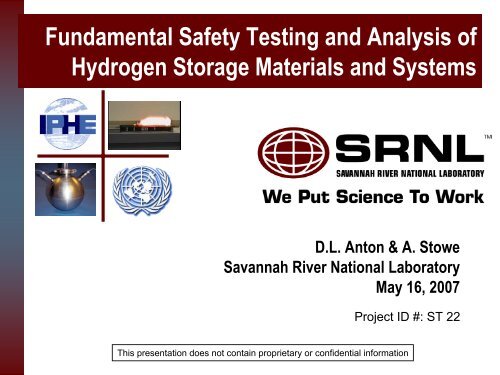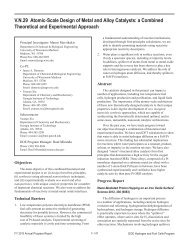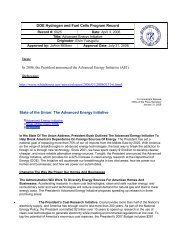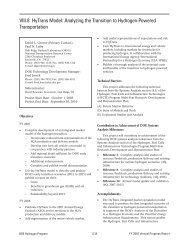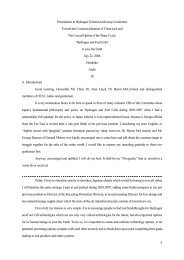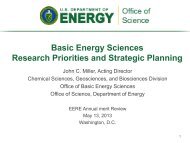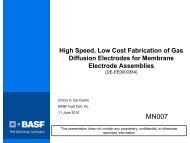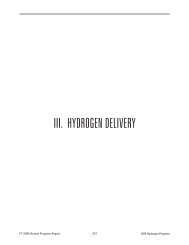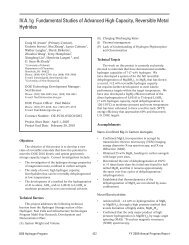Fundamental Safety Testing and Analysis of Hydrogen Storage ...
Fundamental Safety Testing and Analysis of Hydrogen Storage ...
Fundamental Safety Testing and Analysis of Hydrogen Storage ...
Create successful ePaper yourself
Turn your PDF publications into a flip-book with our unique Google optimized e-Paper software.
<strong>Fundamental</strong> <strong>Safety</strong> <strong>Testing</strong> <strong>and</strong> <strong>Analysis</strong> <strong>of</strong><br />
<strong>Hydrogen</strong> <strong>Storage</strong> Materials <strong>and</strong> Systems<br />
D.L. Anton & A. Stowe<br />
Savannah River National Laboratory<br />
May 16, 2007<br />
Project ID #: ST 22<br />
This presentation does not contain proprietary or confidential information
Overview<br />
Timeline<br />
• Start: 10/1/05<br />
• End: 9/30/10<br />
• Percent complete: 10%<br />
Budget<br />
• Funding received in FY06<br />
– $100,000<br />
• Funding for FY07<br />
– $300,000<br />
Barriers Addressed<br />
• Environmental, Health & <strong>Safety</strong><br />
• Gravimetric Density<br />
• Volumetric Density<br />
• System Cost<br />
Partners<br />
• M. Fichtner, Forschungszentrum Karlsruhe,<br />
Germany<br />
• N. Kuriyama, National Institute for Advanced<br />
Industrial Science <strong>and</strong> Technology, Japan<br />
• R. Chahine, Université du Québec à Trois-<br />
Rivières, Canada<br />
• D. Mosher, United Tech. Res. Ctr., USA<br />
• D. Dedrick, S<strong>and</strong>ia NL, USA
DoE Technical Targets<br />
Target 2007 2010 2015<br />
Wt % H 2<br />
(Useable) 4.5 6 9<br />
Vol. Cap. (kg H 2<br />
/L) 0.036 0.045<br />
Cycles 500 1000<br />
.081<br />
1500<br />
Minimum rate (g/s)/kW .02 .02 .02<br />
Minimum/Maximum pressure (atm)<br />
[FC]<br />
Minimum/Maximum ambient<br />
temperature (°C)<br />
8/100 4/100 3/100<br />
-20/50 -30/50 -40/60<br />
Start time to full flow (s) 4 4 0.5<br />
System fill time (min) 10 3 2.5<br />
<strong>Safety</strong><br />
Meet or exceed applicable st<strong>and</strong>ards
Objective<br />
The objective <strong>of</strong> this study are to fundamentally underst<strong>and</strong> the<br />
safety issues regarding solid state hydrogen storage systems<br />
through:<br />
• Development <strong>of</strong> st<strong>and</strong>ard testing techniques to quantitatively<br />
evaluate both materials <strong>and</strong> systems.<br />
• Determine the fundamental thermodynamics & chemical<br />
kinetics <strong>of</strong> environmental reactivity <strong>of</strong> hydrides.<br />
• Develop amelioration methods <strong>and</strong> systems to mitigate the<br />
risks <strong>of</strong> using these systems to acceptable levels.
Task Plan<br />
• Task 1: Risk Assessment<br />
– Assess the potential risks <strong>of</strong> using solid state hydrides<br />
– Test six compounds in three discharge states using st<strong>and</strong>ardized semiquantitative<br />
test methods<br />
• Task 2: Thermodynamics & Chemical Kinetics<br />
– Quantitatively assess chemical reactions <strong>of</strong> compounds with air, water &<br />
other engineering materials<br />
• Task 3: Risk Mitigation<br />
– Quantitatively assess chemical reactions <strong>of</strong> compounds with potential<br />
inhibitors<br />
– Evaluate efficacy <strong>of</strong> inhibitors in laboratory scale tests<br />
• Task 4: Prototype System <strong>Testing</strong><br />
– Design assemble <strong>and</strong> test prototype storage systems to evaluate<br />
effectiveness <strong>of</strong> inhibitor systems.
Materials Test Plan<br />
1. 1. Three Three major major classes classes <strong>of</strong> <strong>of</strong> solid solid state state hydrogen hydrogen storage storage materials materials are are being being<br />
studied: studied: metal metal hydrides, hydrides, complex complex hydrides hydrides & activated activated carbon. carbon.<br />
2. 2. The The three three major major classes classes <strong>of</strong> <strong>of</strong> complex complex hydrides hydrides are are being being evaluated: evaluated:<br />
Alanates, Alanates, Amides Amides & Boronates Boronates<br />
Some Known<br />
Little Known<br />
Little Known<br />
Complete <strong>Analysis</strong><br />
Investigations Initiated<br />
Start if Required<br />
• NaAlH 4 +<br />
4 2%TiCl 3 •<br />
3<br />
AlH AlH 3<br />
•<br />
3<br />
Li Li 3 AlH<br />
3 AlH 6 6<br />
• 2LiH 2LiH + Mg(NH 2 )<br />
2<br />
2 ) •<br />
2<br />
NH NH 3 BH<br />
3 BH 3 3<br />
• Mg Mg 2 NiH<br />
2 NiH 4<br />
•<br />
4<br />
Activated Carbon<br />
• …<br />
• LaNi 5 H 6 • LiBH 4 + MgH 2<br />
• LaNi 5 H 6<br />
• LiBH 4 + MgH 2<br />
Start if Required<br />
• Organic Hydrides<br />
Materials Prep Plan<br />
• Mill to Use Particle Size<br />
– Fully Charged<br />
– Partially Discharged<br />
– Fully Discharged
Task 1: St<strong>and</strong>ard Tests<br />
DOT/UN Doc., Recommendations on the Transport <strong>of</strong><br />
Dangerous Goods, Manual <strong>of</strong> Tests <strong>and</strong> Criteria, 3 rd Revised<br />
Ed., ISBN 92-1-139068-0, (1999).<br />
• Flammability<br />
Flammability Test<br />
Spontaneous Ignition<br />
Burn Rate<br />
•Water Contact<br />
Immersion<br />
Surface Exposure<br />
Water Drop<br />
Water Injection<br />
• St<strong>and</strong>ard Test Method for Pressure <strong>and</strong> Rate <strong>of</strong> Pressure Rise<br />
for Combustible Dusts (ASTM E1226)<br />
P max & (dP/Dt) max<br />
Min. Exp. Conc.<br />
Min. Ignition Energy<br />
Min. Ignition Temp.<br />
Min. Dust Layer Ignition Temp.<br />
• Impact<br />
Sensitivity
Task 1: Impact Sensitivity<br />
• Purpose<br />
– To measure the sensitivity <strong>of</strong> solids to drop<br />
weight impact.<br />
• Procedure<br />
– A ~100 mg sample is placed in the anvil cell<br />
– A 10 kg steel striker dropped from 50mm<br />
impacts the sample in a closed chamber.<br />
– If detonation does not occur, the mass is<br />
raised by 25mm to a maximum <strong>of</strong> 500mm <strong>and</strong><br />
retested un till detonation is detected.<br />
• Needs quantification to measure energy<br />
released.
Task 1 Plans<br />
• Synthesize/acquire bulk quantities <strong>of</strong> fine grained<br />
(>10μm) NH 3 BH 3 , 2LiBH 4 +MgH 2 & AlH 3 for use <strong>and</strong><br />
distribution to IPHE team.<br />
• Perform water contact & flammability experiments<br />
• Identify both solid <strong>and</strong> gaseous reaction products<br />
• Design/develop instrumented impact test based on<br />
BAM Fallhammer Test<br />
• Assess impact sensitivity <strong>of</strong> all materials after humid<br />
air exposure.
Task 2: Thermodynamics & Chemical Kinetics<br />
Quantitative studies will be performed to underst<strong>and</strong> the chemical kinetics<br />
<strong>and</strong> thermo-chemical release <strong>of</strong> these reactions with air, oxygen <strong>and</strong> water<br />
as both liquid <strong>and</strong> vapor as a function <strong>of</strong> temperature. Chemical reactivity<br />
with organic <strong>and</strong> inorganic solutions may also be studied to determine those<br />
fluids which are safe to use as heat transfer <strong>and</strong> synthesis liquids.<br />
Calorimetric studies will be performed to investigate the time-dependent<br />
reaction rates <strong>of</strong> the materials. Time resolved x-ray diffraction facilities will<br />
be used to quantify chemical kinetics <strong>and</strong> reaction products. Depth-resolved<br />
surface analysis will be performed to investigate reaction progress,<br />
mechanisms <strong>and</strong>/or properties <strong>of</strong> inhibiting layers.
Calorimetric Experimental Procedures Established<br />
• Thermodynamic assessment has been initiated on the<br />
2LiBH 4 +MgH 2 system for:<br />
– Water reaction at 30 o C<br />
– Air reactions at 30 o C 0
Thermodynamics <strong>of</strong> Water Contact<br />
Water Hydrolysis Possibilities<br />
• 2LiBH 4 + MgH 2 + 10H 2 O (l) LiOH + 2B(OH) 3 + 2Mg(OH) 2 + 10H 2(g)<br />
• 2LiBH 4 + MgH 2 + 6.5H 2 O (l) LiOH + 0.5Li 2 B 4 O 7 + Mg(OH) 2 + 10H 2(g)<br />
• 2LiBH 4 + MgH 2 + 6H 2 O (l) 2LiBO 2 + Mg(OH) 2 + 10H 2(g)<br />
ΔH 373 = -804 kJ/mole formula unit<br />
ΔG (kJ/Mole)<br />
2LiBH4+MgH2+10H2O(l)=2LiOH+2B(OH)3+Mg(OH)2+10H2(g)<br />
2LiBH4+MgH2+6.5H2O(l)=LiOH+0.5Li2B4O7+Mg(OH)2+10H2(g)<br />
2LiBH4+MgH2+6H2O(l)=2LiBO2+Mg(OH)2+10H2(g)<br />
-900<br />
-950<br />
-1000<br />
-1050<br />
-1100<br />
-1150<br />
-1200<br />
-1250<br />
0 50 100 150 200 250<br />
T (C)<br />
Based on available<br />
thermodynamic data in<br />
JANAF database
Thermo-chemical <strong>Analysis</strong> <strong>of</strong> Water Contact<br />
30 o C<br />
2LiBH 4 + MgH 2 + 6H 2 O (l) 2LiBO 2 + Mg(OH) 2 + 10H 2 (g)<br />
Ar<br />
Theoretical: ΔH 303 = -792 kJ/mole formula unit<br />
Rapid<br />
Initial<br />
Reaction<br />
Membrane<br />
Pierced<br />
Slow<br />
Reaction<br />
Decay<br />
May be due to<br />
product<br />
retardation <strong>of</strong><br />
reaction<br />
water<br />
sample<br />
ΔH=-115kJ/mole<br />
Partially reacted <strong>and</strong>/or not to theoretical products
XRD Results <strong>of</strong> Water Contact<br />
2LiBH 4<br />
+ MgH 2<br />
+ 21H 2<br />
O (g)<br />
2LiBO 2<br />
•8H 2<br />
O + 1 / 2<br />
Mg(OH) 2<br />
+ 1 / 2<br />
MgH 2<br />
+ 9H 2(g)<br />
Thermodynamic data to be identified<br />
MgH 2<br />
Mg(OH) 2<br />
LiBO 2<br />
•8H 2<br />
O<br />
LiBO 2<br />
• Products yield fully hydrated LiBO 2<br />
•H 2<br />
O<br />
• Approximately one half <strong>of</strong> the MgH 2<br />
hydrated<br />
• Difficult to predict thermal release when actual<br />
products do not match predicted
Thermodynamics <strong>of</strong> Air Exposure<br />
Air Exposure Possibilities (oxygen & water vapor only)<br />
• 2LiBH 4 + MgH 2 + 10H 2 O (g) LiOH + 2B(OH) 3 + 2Mg(OH) 2 + 10H 2(g)<br />
• 2LiBH 4 + MgH 2 + 5O 2(g) 2LiOH + 2B(OH) 3 + Mg(OH) 2<br />
ΔH 373 = -3,304 kJ/mole formula unit<br />
• 2LiBH 4 + MgH 2 + 6.5H 2 O (g) LiOH + 0.5Li 2 B 4 O 7 + Mg(OH) 2 + 10H 2(g)<br />
• 2LiBH 4 + MgH 2 + 3.25O 2(g) LiOH + 0.5Li 2 B 4 O 7 + Mg(OH) 2 + 3.5H 2(g)<br />
• 2LiBH 4 + MgH 2 + 6H 2 O (g) 2LiBO 2 + Mg(OH) 2 + 10H 2(g)<br />
• 2LiBH 4 + MgH 2 + 3O 2(g) 2LiBO 2 + Mg(OH) 2 + 4H 2(g)<br />
ΔG (kJ/Mole)<br />
0<br />
-500<br />
-1000<br />
-1500<br />
-2000<br />
-2500<br />
-3000<br />
2LiBH4+MgH2+6H2O(g)=2LiBO2+Mg(OH)2+10H2(g)<br />
2LiBH4+MgH2+3O2(g)=2LiBO2+Mg(OH)2+4H2(g)<br />
2LiBH4+MgH2+10H2O(g)=2LiOH+2B(OH)3+Mg(OH)2+10H2(g)<br />
2LiBH4+MgH2+5O2(g)=2LiOH+2B(OH)3+Mg(OH)2<br />
2LiBH4+MgH2+6.5H2O(g)=LiOH+0.5Li2B4O7+Mg(OH)2+10H2(g)<br />
2LiBH4+MgH2+3.25O2(g)=LiOH+0.5Li2B4O7+Mg(OH)2+3.5H2(g)<br />
water vapor<br />
oxygen<br />
-3500<br />
-4000<br />
0 50 100 150 200 250<br />
Temperature ( o C)<br />
Based on available<br />
thermodynamic data in<br />
JANAF database
Thermo-chemical <strong>Analysis</strong> <strong>of</strong> Dry Air Exposure<br />
Gas<br />
Outlet<br />
Conditioned<br />
Temperature & Humidity<br />
Gas<br />
Inlet<br />
30 o C<br />
2LiBH 4 + MgH 2 + 5O 2(g) 2LiOH + 2B(OH) 3 + Mg(OH) 2<br />
0%RH<br />
Initial<br />
Reaction<br />
Slow<br />
Reaction<br />
Decay<br />
May be due to<br />
product<br />
retardation <strong>of</strong><br />
reaction<br />
Gas<br />
Flow<br />
Initiated<br />
sample
XRD <strong>Analysis</strong> <strong>of</strong> Dry Air Exposure<br />
30 o C<br />
2LiBH 4<br />
+ MgH 2<br />
+ 5O 2(g)<br />
XLi 2<br />
(B 12<br />
H 12<br />
)•7(H 2<br />
O) + MgH 2<br />
+ LiBH 4<br />
+ YLi i<br />
B j<br />
O k<br />
H l<br />
0%RH<br />
• Oxidation results in<br />
intermediate Li 2 (B 12 H 12 )•7(H 2 O)<br />
• Water formation results from<br />
dissociated H from LiBH 4<br />
<strong>and</strong> O 2<br />
• Numerous unidentified peaks<br />
are likely due to unidentified<br />
Li x B y -oxide/hydroxide/hydrate<br />
• LiBH 4 only partially reacted &<br />
MgH 2 unreacted<br />
Thermodynamic data to be evaluated<br />
Intermediate oxide/hydroxide/hydrates to be<br />
identified <strong>and</strong> thermodynamic data evaluated<br />
MgH 2<br />
Li 2<br />
(B 12<br />
H 12<br />
)•7H 2<br />
O<br />
LiBH 4
Task 2 Plans<br />
• Evaluate theoretical thermodynamics for water <strong>and</strong> air<br />
exposures initially <strong>of</strong> NH 3 BH 3 , 2LiBH 4 +MgH 2 , 2LiH+Mg(NH 2 ) 2 &<br />
AlH 3 followed by NaAlH 4 , Mg 2 NiH 4 & LaNiH 6 .<br />
• Perform calorimetric experiments for water exposure at<br />
0
Task 3: Risk Mitigation<br />
System risk analyses will be performed <strong>and</strong> methods <strong>of</strong> mitigating these risks<br />
including exposure to air <strong>and</strong> humidity will be investigated. These mitigation<br />
methods may take the form <strong>of</strong> either materials modifications or system level<br />
methods which would lessen the probability or effects <strong>of</strong> environmental<br />
exposure. Proposed methods for inhibiting reactions include the application <strong>of</strong><br />
thin film coatings or the use <strong>of</strong> liquid film inhibitors. The fundamental<br />
effectiveness <strong>of</strong> these mitigations methods will<br />
be determined with identification <strong>of</strong> the most<br />
successful identified.<br />
No<br />
Mitigation<br />
With<br />
Mitigation
Task 3 Plan<br />
• Identify risk mitigation strategies including contaminants <strong>and</strong> poisons which<br />
will reduce exothermic releases.<br />
• Evaluate theoretical thermodynamics <strong>of</strong> mitigation strategies for water <strong>and</strong><br />
air exposures initially on NH 3 BH 3 , 2LiBH 4 +MgH 2 , 2LiH+Mg(NH 2 ) 2 , AlH 3 &<br />
NaAlH 4 .<br />
• Perform calorimetric experiments <strong>of</strong> mitigation strategies for water exposure<br />
at 0
Evaluation tests on risk mitigations strategies<br />
will be performed to validate their efficacy.<br />
Prototype vessels <strong>of</strong> approximately one liter<br />
in volume will be filled with promising<br />
hydrogen storage materials <strong>and</strong> tested for<br />
vessel rupture, water ingestion, humid air<br />
ingestion etc. to determine the effect <strong>of</strong> larger<br />
contained amounts <strong>of</strong> hydride. These tests<br />
will be derived from internationally accepted<br />
st<strong>and</strong>ards for testing chemical <strong>and</strong><br />
pressurized containers with the aim <strong>of</strong> setting<br />
st<strong>and</strong>ards for testing solid state hydrogen<br />
storage containment. Time will be allotted for<br />
interacting with st<strong>and</strong>ards setting agencies to<br />
guide development <strong>of</strong> these practices.<br />
Task 4: Prototype System <strong>Testing</strong>
Participation Matrix<br />
1.0 Risk Assessment<br />
1.1 Perform Formal Risk<br />
SRNL FZK AIST SNL UTR UTRC<br />
Assessment<br />
x<br />
1.2 Bulk Tests<br />
x x x x x<br />
1.3 Dust Cloud Tests x x x<br />
2.0 Thermodynamics &<br />
Chemical Kinetics<br />
2.1 Calorimetry<br />
x<br />
2.2 RT-XRD x<br />
2.3 TGA MS x<br />
2.4 Kinetics Modeling<br />
x x<br />
3.0 Risk Mitigation<br />
3.4 Risk Mitigation Strategy<br />
x x x<br />
3.1 Calorimetry<br />
x<br />
3.2 TGA/MS x<br />
3.3 Hazards Tests<br />
x x<br />
3.5 Surface <strong>Analysis</strong> x<br />
4.0 Prototype System<br />
4.1 System Design x<br />
4.2 System Reaction Modeling x x x<br />
4.3 Subscale prototype testing x<br />
4.4 System Design Strategy x x<br />
4.5 Materials Preparation x x<br />
4.6 Sytem Evaluation x
SRNL FYs ’07 & ‘08 Work<br />
• Coordinate IPHE team to complete experimental analysis,<br />
compile results <strong>and</strong> disseminate findings <strong>and</strong> conclusions.<br />
• Complete laboratory safety protocols, initiate <strong>and</strong> complete<br />
st<strong>and</strong>ardized tests UN hazards analysis tests on NH 3 BH 3 ,<br />
2LiBH 4 +MgH 2 , C [a] & AlH 3 .<br />
• Complete thermodynamic assessment <strong>of</strong> environmental<br />
exposure reactions.<br />
• Perform calorimetric experiments on environmental exposure<br />
reactions, assess reaction products <strong>and</strong> chemical kinetics as a<br />
function <strong>of</strong> T & %RH.<br />
• Determine chemical reaction & thermal discharge rates to assess<br />
risks.
Publication in Press<br />
<strong>Fundamental</strong> <strong>Safety</strong> <strong>Testing</strong> <strong>and</strong> <strong>Analysis</strong> <strong>of</strong> <strong>Hydrogen</strong><br />
<strong>Storage</strong> Materials & Systems<br />
D. Anton, D. Mosher,<br />
M. Fichtner, D. Dedrick, R. Chahine, E. Akiba <strong>and</strong> N. Kuriyama<br />
Proceedings <strong>of</strong> the<br />
2 nd International Conference on <strong>Hydrogen</strong> <strong>Safety</strong><br />
September 11-13, 2007<br />
San Sebastian, Spain


